Object Modeling Report: Requirements Analysis for Swifty's SUMS
VerifiedAdded on 2022/07/28
|17
|1662
|22
Report
AI Summary
This report provides a detailed analysis and object modeling of the Swifty Unified Management System (SUMS), a system designed for a vehicle rental business. The report begins with an introduction to the project and outlines both non-functional and functional requirements, including reliability, performance, security, and usability considerations. It then presents a series of UML diagrams, including use case diagrams illustrating system functionalities such as vehicle management, payment processing, customer management, and vehicle tracking. The use case descriptions provide detailed scenarios, actors, and preconditions for each use case. The report also includes a domain model class diagram that depicts the system's entities and their relationships. The conclusion summarizes the benefits of the system, emphasizing its scalability and flexibility. The report is a comprehensive document that aids in understanding the system's design and requirements.

Running head: OBJECT MODELLING
OBJECT MODELLING
Name of student
Name of university
Author’s note:
OBJECT MODELLING
Name of student
Name of university
Author’s note:
Paraphrase This Document
Need a fresh take? Get an instant paraphrase of this document with our AI Paraphraser
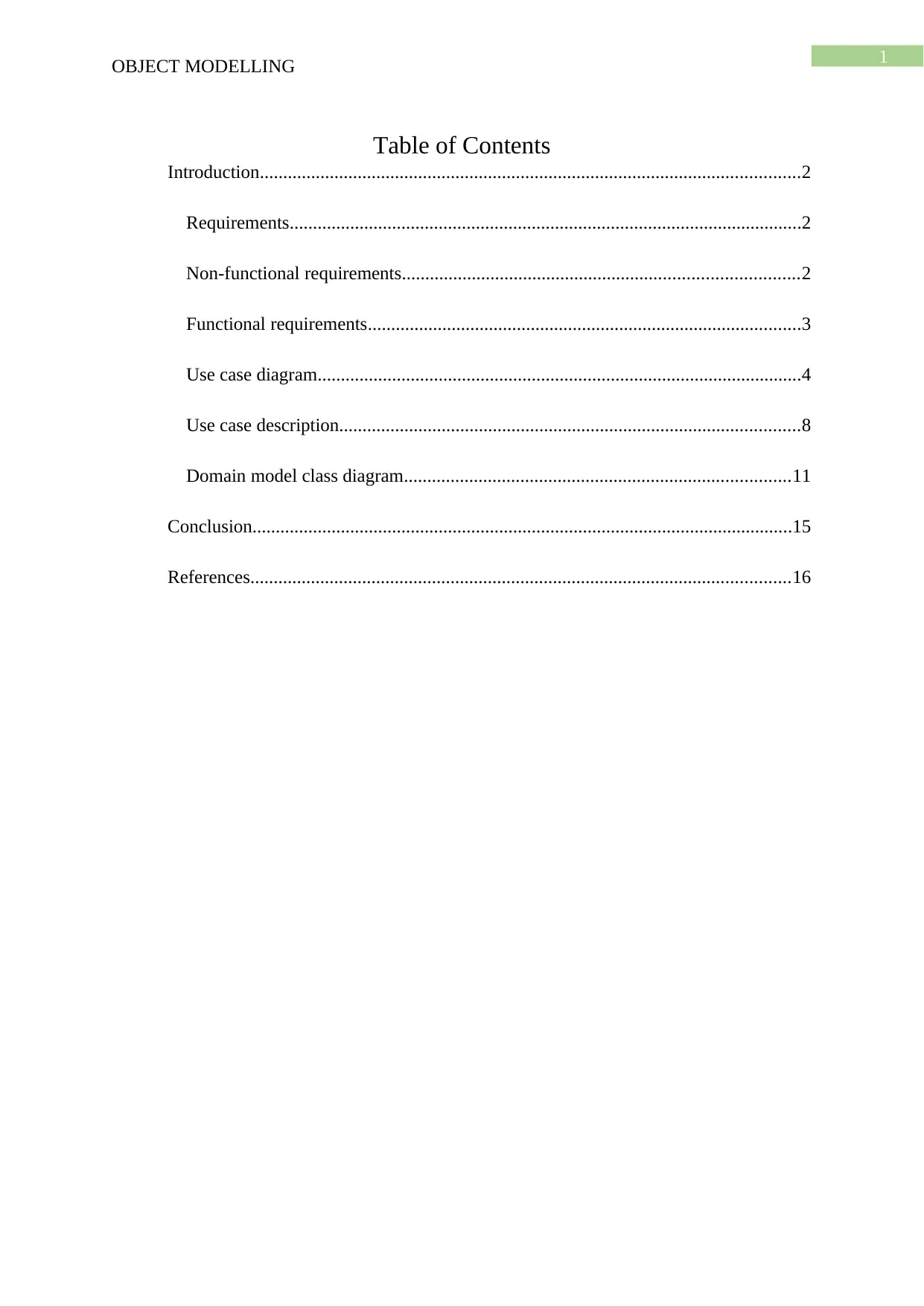
1
OBJECT MODELLING
Table of Contents
Introduction....................................................................................................................2
Requirements..............................................................................................................2
Non-functional requirements.....................................................................................2
Functional requirements.............................................................................................3
Use case diagram........................................................................................................4
Use case description...................................................................................................8
Domain model class diagram...................................................................................11
Conclusion....................................................................................................................15
References....................................................................................................................16
OBJECT MODELLING
Table of Contents
Introduction....................................................................................................................2
Requirements..............................................................................................................2
Non-functional requirements.....................................................................................2
Functional requirements.............................................................................................3
Use case diagram........................................................................................................4
Use case description...................................................................................................8
Domain model class diagram...................................................................................11
Conclusion....................................................................................................................15
References....................................................................................................................16
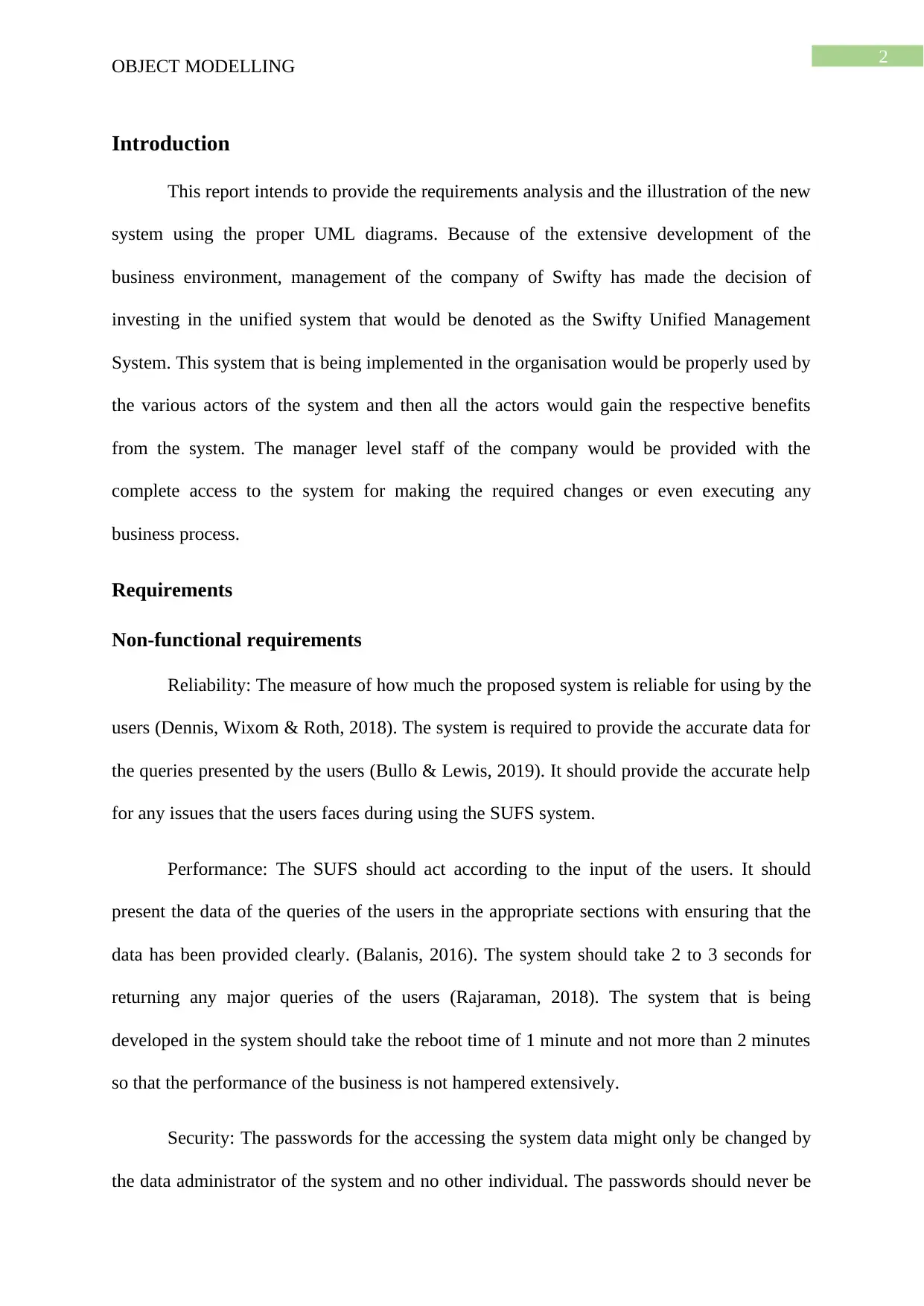
2
OBJECT MODELLING
Introduction
This report intends to provide the requirements analysis and the illustration of the new
system using the proper UML diagrams. Because of the extensive development of the
business environment, management of the company of Swifty has made the decision of
investing in the unified system that would be denoted as the Swifty Unified Management
System. This system that is being implemented in the organisation would be properly used by
the various actors of the system and then all the actors would gain the respective benefits
from the system. The manager level staff of the company would be provided with the
complete access to the system for making the required changes or even executing any
business process.
Requirements
Non-functional requirements
Reliability: The measure of how much the proposed system is reliable for using by the
users (Dennis, Wixom & Roth, 2018). The system is required to provide the accurate data for
the queries presented by the users (Bullo & Lewis, 2019). It should provide the accurate help
for any issues that the users faces during using the SUFS system.
Performance: The SUFS should act according to the input of the users. It should
present the data of the queries of the users in the appropriate sections with ensuring that the
data has been provided clearly. (Balanis, 2016). The system should take 2 to 3 seconds for
returning any major queries of the users (Rajaraman, 2018). The system that is being
developed in the system should take the reboot time of 1 minute and not more than 2 minutes
so that the performance of the business is not hampered extensively.
Security: The passwords for the accessing the system data might only be changed by
the data administrator of the system and no other individual. The passwords should never be
OBJECT MODELLING
Introduction
This report intends to provide the requirements analysis and the illustration of the new
system using the proper UML diagrams. Because of the extensive development of the
business environment, management of the company of Swifty has made the decision of
investing in the unified system that would be denoted as the Swifty Unified Management
System. This system that is being implemented in the organisation would be properly used by
the various actors of the system and then all the actors would gain the respective benefits
from the system. The manager level staff of the company would be provided with the
complete access to the system for making the required changes or even executing any
business process.
Requirements
Non-functional requirements
Reliability: The measure of how much the proposed system is reliable for using by the
users (Dennis, Wixom & Roth, 2018). The system is required to provide the accurate data for
the queries presented by the users (Bullo & Lewis, 2019). It should provide the accurate help
for any issues that the users faces during using the SUFS system.
Performance: The SUFS should act according to the input of the users. It should
present the data of the queries of the users in the appropriate sections with ensuring that the
data has been provided clearly. (Balanis, 2016). The system should take 2 to 3 seconds for
returning any major queries of the users (Rajaraman, 2018). The system that is being
developed in the system should take the reboot time of 1 minute and not more than 2 minutes
so that the performance of the business is not hampered extensively.
Security: The passwords for the accessing the system data might only be changed by
the data administrator of the system and no other individual. The passwords should never be
⊘ This is a preview!⊘
Do you want full access?
Subscribe today to unlock all pages.

Trusted by 1+ million students worldwide
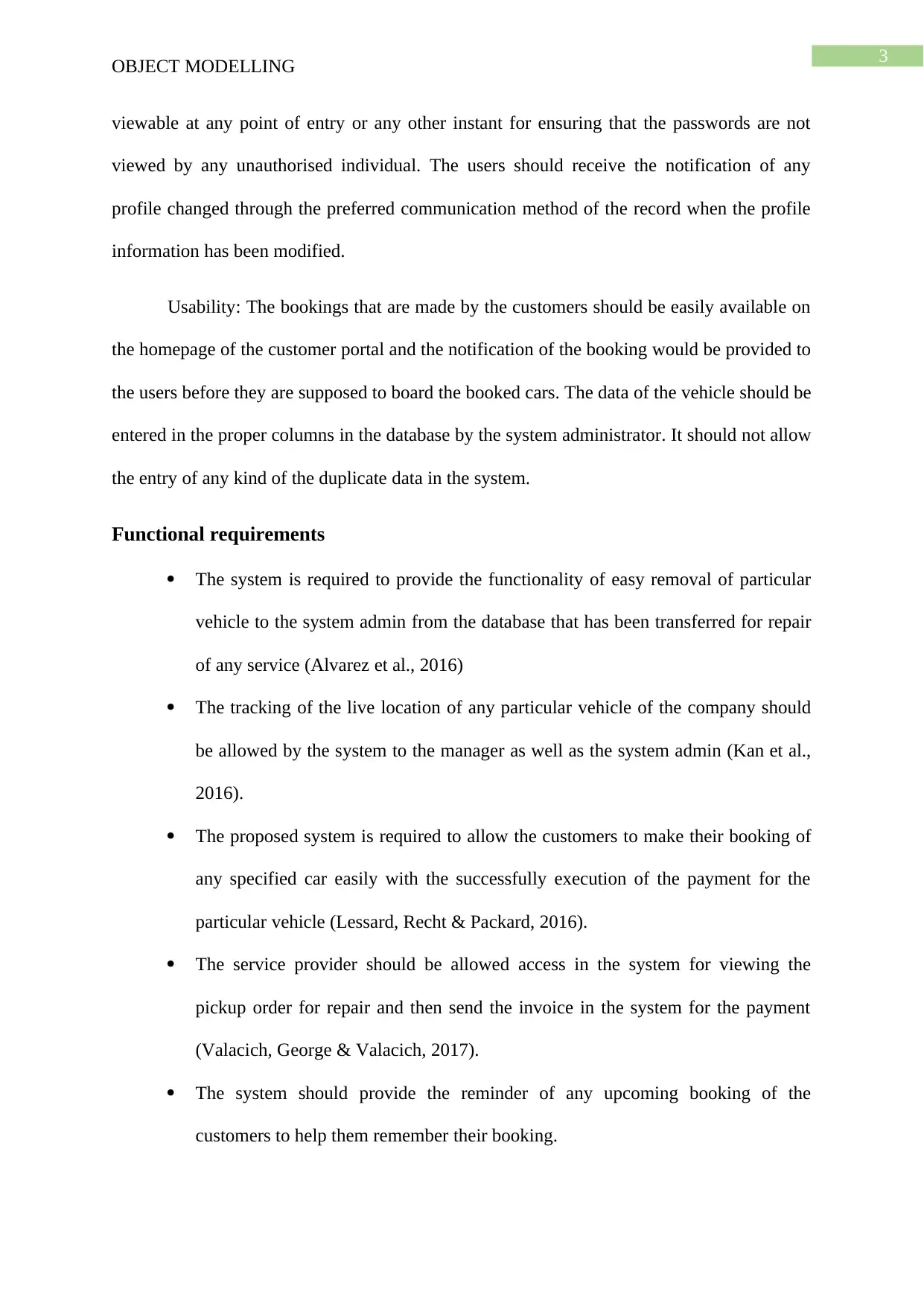
3
OBJECT MODELLING
viewable at any point of entry or any other instant for ensuring that the passwords are not
viewed by any unauthorised individual. The users should receive the notification of any
profile changed through the preferred communication method of the record when the profile
information has been modified.
Usability: The bookings that are made by the customers should be easily available on
the homepage of the customer portal and the notification of the booking would be provided to
the users before they are supposed to board the booked cars. The data of the vehicle should be
entered in the proper columns in the database by the system administrator. It should not allow
the entry of any kind of the duplicate data in the system.
Functional requirements
The system is required to provide the functionality of easy removal of particular
vehicle to the system admin from the database that has been transferred for repair
of any service (Alvarez et al., 2016)
The tracking of the live location of any particular vehicle of the company should
be allowed by the system to the manager as well as the system admin (Kan et al.,
2016).
The proposed system is required to allow the customers to make their booking of
any specified car easily with the successfully execution of the payment for the
particular vehicle (Lessard, Recht & Packard, 2016).
The service provider should be allowed access in the system for viewing the
pickup order for repair and then send the invoice in the system for the payment
(Valacich, George & Valacich, 2017).
The system should provide the reminder of any upcoming booking of the
customers to help them remember their booking.
OBJECT MODELLING
viewable at any point of entry or any other instant for ensuring that the passwords are not
viewed by any unauthorised individual. The users should receive the notification of any
profile changed through the preferred communication method of the record when the profile
information has been modified.
Usability: The bookings that are made by the customers should be easily available on
the homepage of the customer portal and the notification of the booking would be provided to
the users before they are supposed to board the booked cars. The data of the vehicle should be
entered in the proper columns in the database by the system administrator. It should not allow
the entry of any kind of the duplicate data in the system.
Functional requirements
The system is required to provide the functionality of easy removal of particular
vehicle to the system admin from the database that has been transferred for repair
of any service (Alvarez et al., 2016)
The tracking of the live location of any particular vehicle of the company should
be allowed by the system to the manager as well as the system admin (Kan et al.,
2016).
The proposed system is required to allow the customers to make their booking of
any specified car easily with the successfully execution of the payment for the
particular vehicle (Lessard, Recht & Packard, 2016).
The service provider should be allowed access in the system for viewing the
pickup order for repair and then send the invoice in the system for the payment
(Valacich, George & Valacich, 2017).
The system should provide the reminder of any upcoming booking of the
customers to help them remember their booking.
Paraphrase This Document
Need a fresh take? Get an instant paraphrase of this document with our AI Paraphraser
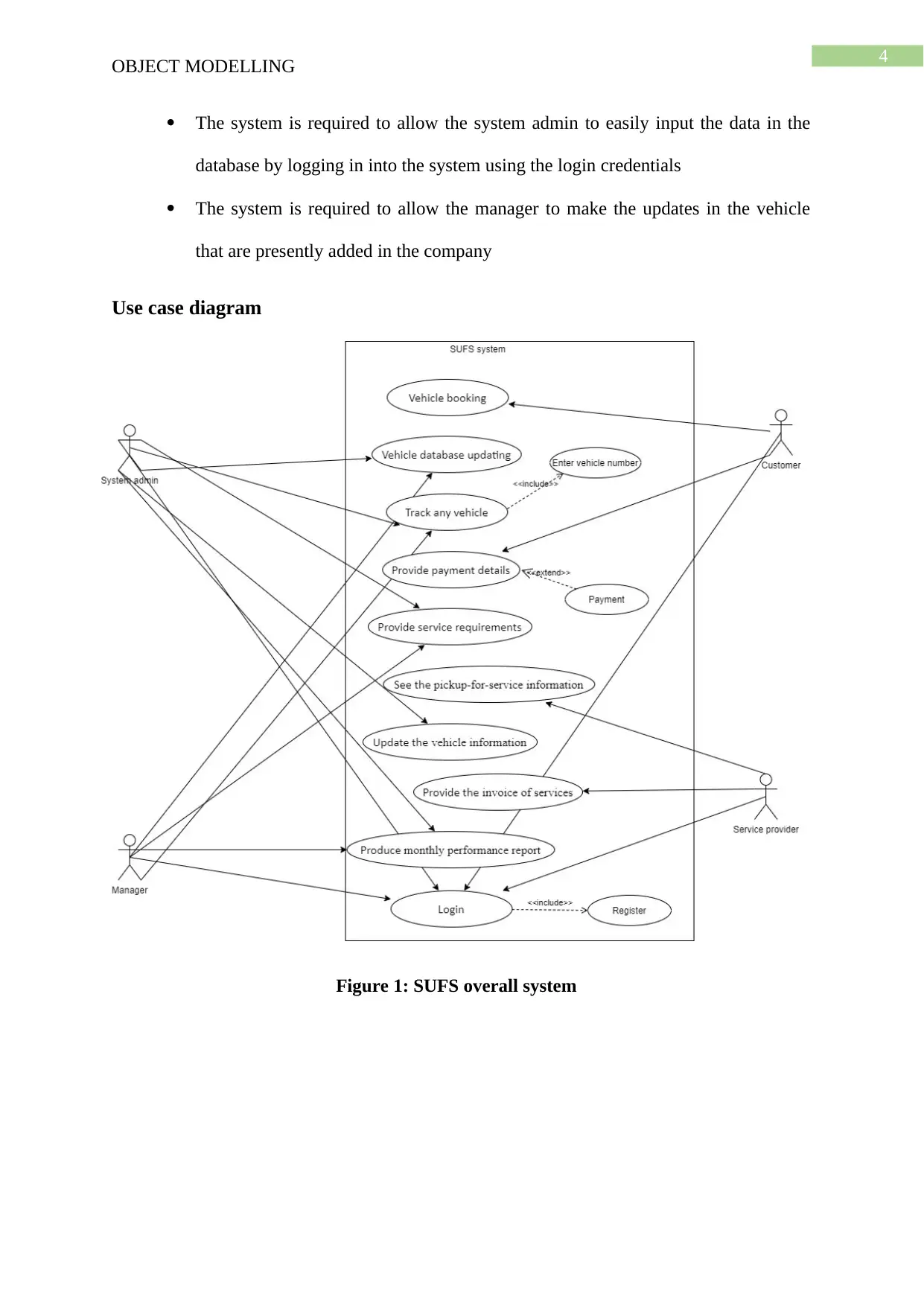
4
OBJECT MODELLING
The system is required to allow the system admin to easily input the data in the
database by logging in into the system using the login credentials
The system is required to allow the manager to make the updates in the vehicle
that are presently added in the company
Use case diagram
Figure 1: SUFS overall system
OBJECT MODELLING
The system is required to allow the system admin to easily input the data in the
database by logging in into the system using the login credentials
The system is required to allow the manager to make the updates in the vehicle
that are presently added in the company
Use case diagram
Figure 1: SUFS overall system

5
OBJECT MODELLING
Figure 2: vehicle management subsytem
OBJECT MODELLING
Figure 2: vehicle management subsytem
⊘ This is a preview!⊘
Do you want full access?
Subscribe today to unlock all pages.

Trusted by 1+ million students worldwide
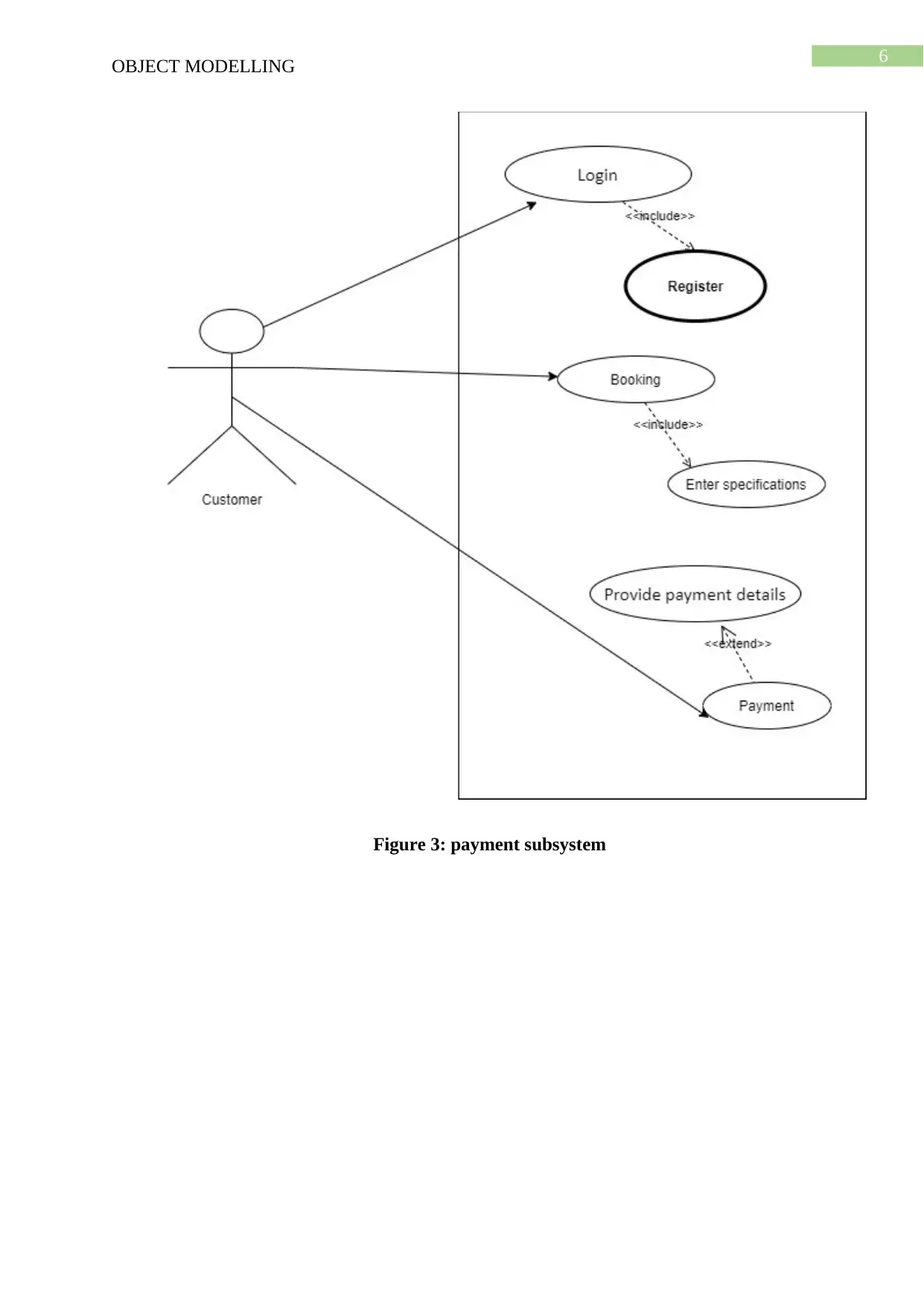
6
OBJECT MODELLING
Figure 3: payment subsystem
OBJECT MODELLING
Figure 3: payment subsystem
Paraphrase This Document
Need a fresh take? Get an instant paraphrase of this document with our AI Paraphraser
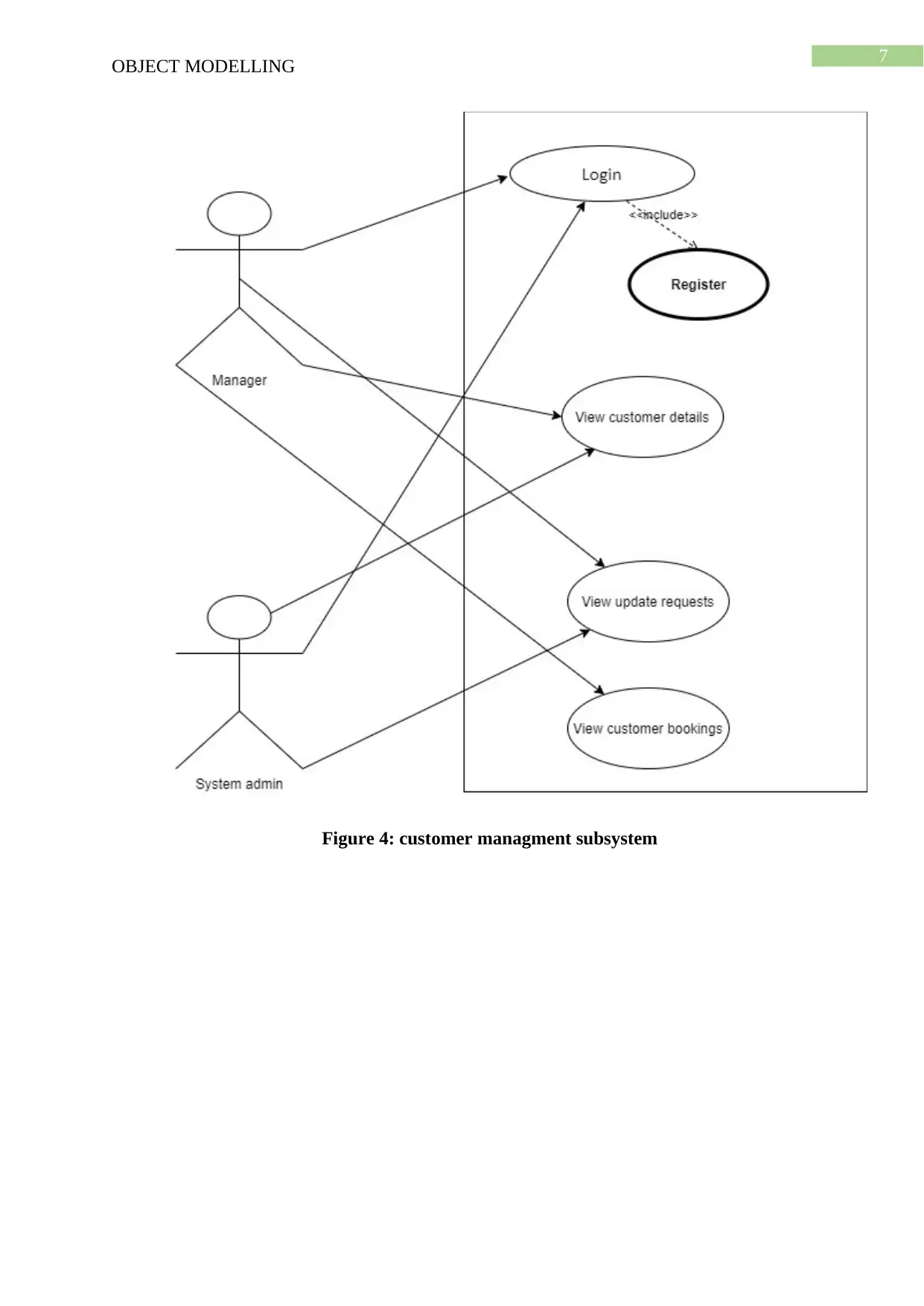
7
OBJECT MODELLING
Figure 4: customer managment subsystem
OBJECT MODELLING
Figure 4: customer managment subsystem
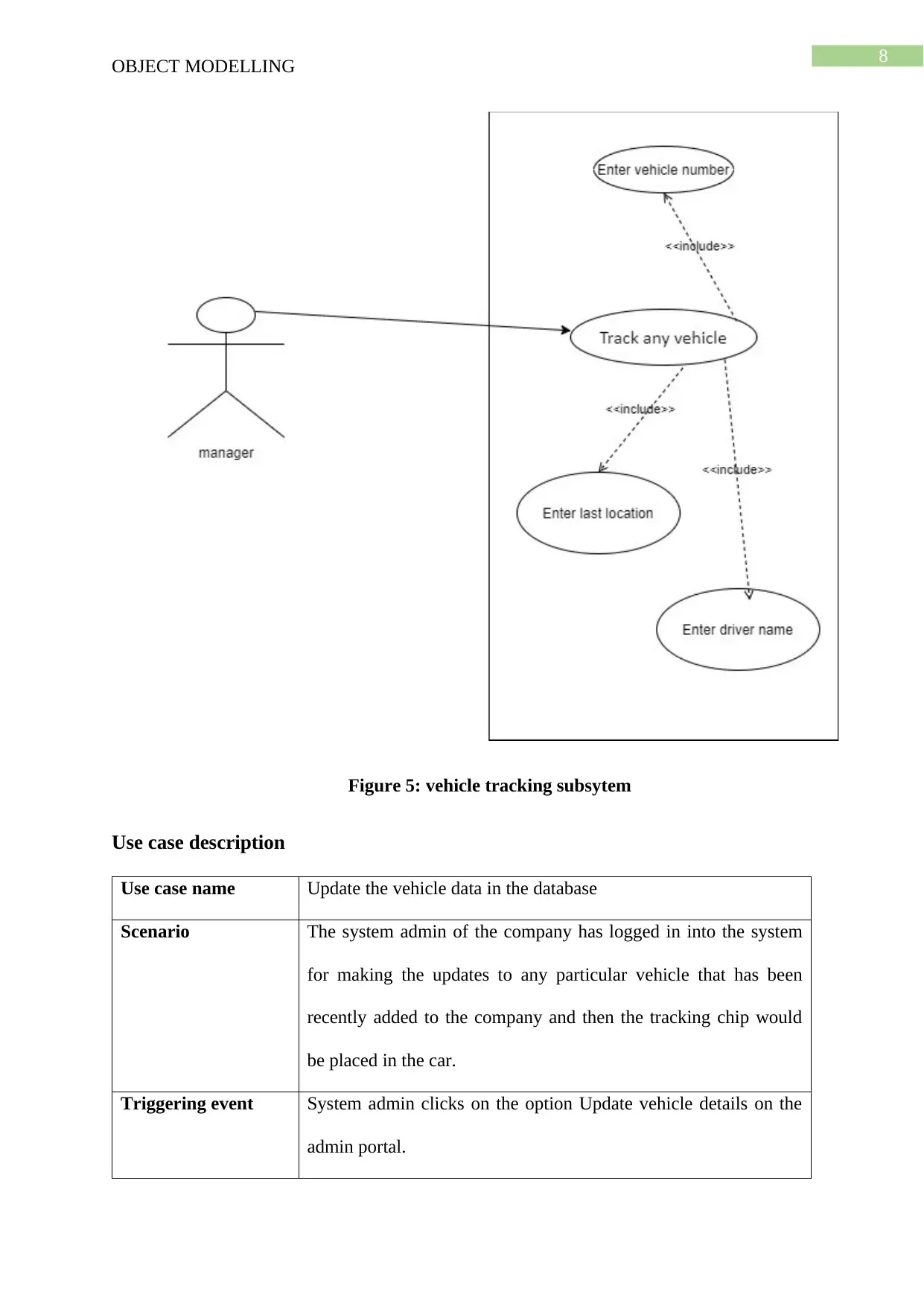
8
OBJECT MODELLING
Figure 5: vehicle tracking subsytem
Use case description
Use case name Update the vehicle data in the database
Scenario The system admin of the company has logged in into the system
for making the updates to any particular vehicle that has been
recently added to the company and then the tracking chip would
be placed in the car.
Triggering event System admin clicks on the option Update vehicle details on the
admin portal.
OBJECT MODELLING
Figure 5: vehicle tracking subsytem
Use case description
Use case name Update the vehicle data in the database
Scenario The system admin of the company has logged in into the system
for making the updates to any particular vehicle that has been
recently added to the company and then the tracking chip would
be placed in the car.
Triggering event System admin clicks on the option Update vehicle details on the
admin portal.
⊘ This is a preview!⊘
Do you want full access?
Subscribe today to unlock all pages.

Trusted by 1+ million students worldwide

9
OBJECT MODELLING
Brief description The system admin of the company has logged in into the system
for making the updates to the database of the vehicles. The system
admin would enter the provided credentials in the login form of
the system for gaining the access in the system. when the system
has verified the credentials, then the access to the system has been
provided to the system admin. The system admin then clicks on
the option of update vehicle details on the left side menu of the
admin portal. When the system confirms the selection, the vehicle
form has been provided to the system admin that would request
the system admin to enter the data such as the make, the model,
the year, the seating capacity, the mechanical specifications and
the facilities that are available in the car. After entering all the
details in the system, the system would verify the details entered
and when all the details have been verified by the system, the
information of the vehicle would be added in the vehicle database.
Actors System admin
Related use cases Login, Register, access portal of admin
Stakeholders System admin, manager, suppliers
Preconditions System admin is required to be properly authenticated before
allowed with the access of the system. System admin should
provide the accurate details of the sign in into the system
Postconditions Confirmation of the update of the database has been provided and
the data of the car has been updated.
Flow of activities Actor System
1. The system admin would 1) when the system has
OBJECT MODELLING
Brief description The system admin of the company has logged in into the system
for making the updates to the database of the vehicles. The system
admin would enter the provided credentials in the login form of
the system for gaining the access in the system. when the system
has verified the credentials, then the access to the system has been
provided to the system admin. The system admin then clicks on
the option of update vehicle details on the left side menu of the
admin portal. When the system confirms the selection, the vehicle
form has been provided to the system admin that would request
the system admin to enter the data such as the make, the model,
the year, the seating capacity, the mechanical specifications and
the facilities that are available in the car. After entering all the
details in the system, the system would verify the details entered
and when all the details have been verified by the system, the
information of the vehicle would be added in the vehicle database.
Actors System admin
Related use cases Login, Register, access portal of admin
Stakeholders System admin, manager, suppliers
Preconditions System admin is required to be properly authenticated before
allowed with the access of the system. System admin should
provide the accurate details of the sign in into the system
Postconditions Confirmation of the update of the database has been provided and
the data of the car has been updated.
Flow of activities Actor System
1. The system admin would 1) when the system has
Paraphrase This Document
Need a fresh take? Get an instant paraphrase of this document with our AI Paraphraser

10
OBJECT MODELLING
enter the provided
credentials in the login form
of the system for gaining
the access in the system.
2. The system admin then
clicks on the option of
update vehicle details on
the left side menu of the
admin portal.
3. The system admin provides
data such as the make, the
model, the year, the seating
capacity, the mechanical
specifications and the
facilities that are available
in the car.
verified the credentials,
then the access to the
system has been provided to
the system admin.
2) When the system confirms
the selection, the vehicle
form has been provided to
the system admin.
3) the system would verify the
details entered
4) the information of the
vehicle would be added in
the vehicle database.
Exceptional
conditions
Login credentials is invalid
Information of the vehicle is not authentic
OBJECT MODELLING
enter the provided
credentials in the login form
of the system for gaining
the access in the system.
2. The system admin then
clicks on the option of
update vehicle details on
the left side menu of the
admin portal.
3. The system admin provides
data such as the make, the
model, the year, the seating
capacity, the mechanical
specifications and the
facilities that are available
in the car.
verified the credentials,
then the access to the
system has been provided to
the system admin.
2) When the system confirms
the selection, the vehicle
form has been provided to
the system admin.
3) the system would verify the
details entered
4) the information of the
vehicle would be added in
the vehicle database.
Exceptional
conditions
Login credentials is invalid
Information of the vehicle is not authentic
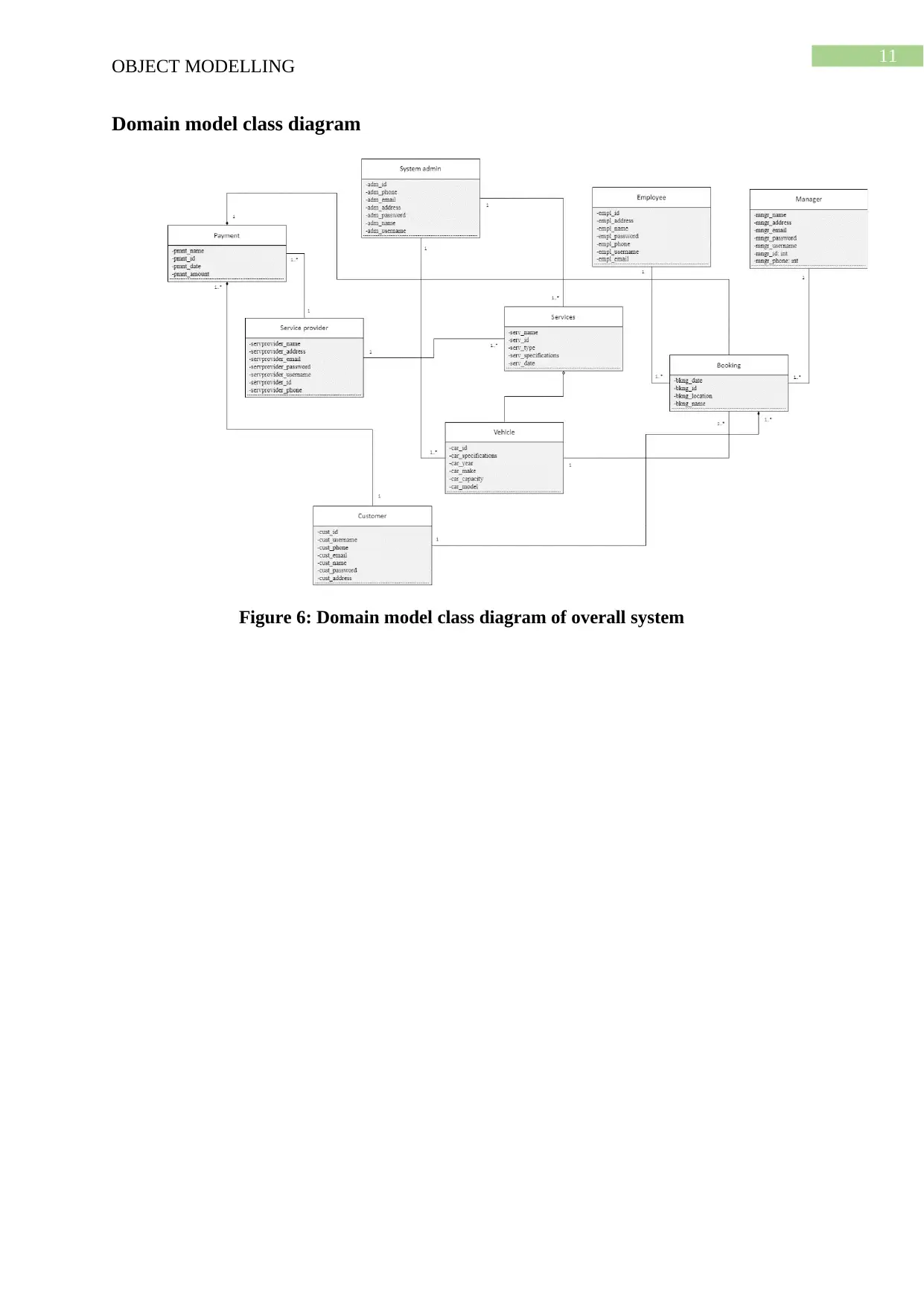
11
OBJECT MODELLING
Domain model class diagram
Figure 6: Domain model class diagram of overall system
OBJECT MODELLING
Domain model class diagram
Figure 6: Domain model class diagram of overall system
⊘ This is a preview!⊘
Do you want full access?
Subscribe today to unlock all pages.

Trusted by 1+ million students worldwide
1 out of 17
Related Documents
Your All-in-One AI-Powered Toolkit for Academic Success.
+13062052269
info@desklib.com
Available 24*7 on WhatsApp / Email
![[object Object]](/_next/static/media/star-bottom.7253800d.svg)
Unlock your academic potential
Copyright © 2020–2025 A2Z Services. All Rights Reserved. Developed and managed by ZUCOL.



